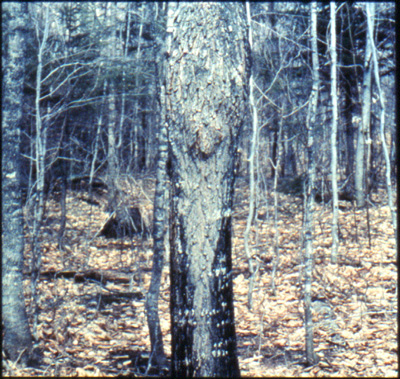
| Home |
| Tutorial |
| Photo Gallery |
| List of Defects |
| Links |
| Bark Distortion |
| Bird Peck |
| Bumps |
| Burls |
| Butt Scars |
| Butt Swells |
| Cankers |
| Conks |
| Epicormic Branches |
| Flanges |
| Flutes |
| Forks |
| Galls |
| Holes |
| Knots |
| Lesions |
| Limbs |
| Ring Shake |
| Rot |
| Seams |
| Soak |
| Splits |
| Wounds |
Significance: A true burl is a surface indication that the grain in the wood is contorted into a wavy, curly, or bird's-eye effect- both within the burl and in the immediately surrounding stem wood. Other similar apparently sound abnormalities such as incipient cankers and galls may contain variable quantities of bark rot, twig knots, and even boring-insect channels.
In veneer logs, a burl is not a degrader if it causes no more damage than is covered in the definition for a standard defect. One standard defect is admitted in logs 8 through 10 feet (2.4 through 3 m) meters long, two in logs 12 through 13 feet (3.7 through 4 m), and three in logs 14 through 16 feet (4.3 through 4.9 m).
In factory logs, the burl, if it can be identified correctly, technically is not a degrader. Nevertheless, because of the difficulties encountered in identifying tree burls, all features popularly regarded as burls are acknowledged as grading defects in factory-lumber logs.

In construction logs, burls are considered degraders because the disturbance in the grain unquestionably weakens construction material.
Even though burls are log grade defects in many instances, they merit added consideration for another important reason. Most true burls have a considerable monetary value in themselves because of their peculiar structure and appearance. Frequently, larger burls of California-laurel, nothern red oak, and black walnut are cut into fancy decorative veneers for use in furniture and wall decorations and as novelties such as fruit bowls and trays. In many areas, smaller burls from birch, magnolia, hard maple, and yellow-poplar are collected and sold for processing into novelty items.

